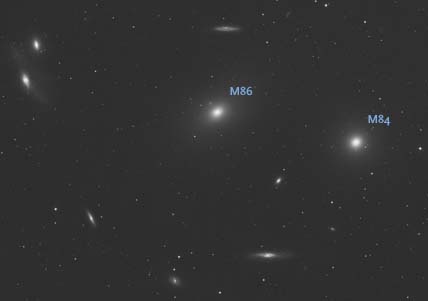Imagine if the 2010 census-takers had carefully counted all the residents of Texas and then, based on the Lone Star State's population density, tried to estimate how many people lived in the entire U.S. The total would be off badly, of course, having overlooked the close-packed residents in the Northeast states, Illinois, and California.
But that's the approach astronomers have had to use when guesstimating the population of stars in the universe, applying what's termed the initial mass function for our Milky Way to all the other galaxies out there. Using our galaxy's 200 to 400 billion stars as a cosmic rule of thumb, and pegging the number of galaxies at 100 billion or more, they get a ballpark estimate of 10 to 100 septillion (1022 to 1023) stars in all.

The Virgo Cluster contains roughly 1,300 galaxies, including the enormous ellipticals M86 and M84. Click on the image for a larger version.
Digitized Sky Survey
As staggering as this number is, it's too low, according to just-published observations by Pieter van Dokkum (Yale University) and Charlie Conroy (Harvard-Smithsonian Center for Astrophysics). The two astronomers studied eight massive elliptical galaxies in the Virgo and Coma clusters using the Keck I telescope on Mauna Kea. Their spectra reveal two distinct spectral signatures that could only come from red dwarfs, dim stars with masses less than a third that of our Sun.
Red dwarfs are very faint, typically giving off only 1⁄10,000 as much light as the Sun. Barnard's Star, a well-known example just 6 light-years from us, would be be an imperceptible magnitude 39 (at infrared wavelengths) if it were in one of these galaxies. So to detect the dwarfs' telltale emissions at all, Dokkum and Conroy reason that red-dwarf stars must make up at least 80% of all the stars (and 60% of the mass) in the elliptical galaxies they studied — some 20 times the abundance of red dwarfs in the Milky Way!
If most galaxies are typically this "bottom heavy," then the total number of stars must be about three times previous estimates. More importantly, the new result signals to cosmologists that different galaxies have ended up with different mixes of stars. Ellipticals, for example, probably attained their huge masses from gobbling up other galaxies in their vicinity.
A glut of red dwarfs might mean that the interiors of nearby galaxies contain less dark matter — mysterious and unseen, yet detectable by its gravitational effects — than previously calculated. The new results are also at odds with speculations that the oldest galaxies (those seen at high redshifts) are deficient in red dwarfs.
An independent "census" of galaxies and the stars they contain is expected from the European Space Agency's Herschel space telescope, which has been measuring the luminosity of distant galaxies at infrared wavelengths — at which red dwarfs emit most strongly.
Van Dokkum and Conroy published their results in the December 1st's Nature. (Interestingly, another report in the same issue describes the first-ever atmospheric spectrum of a super-Earth orbiting a red dwarf). Both Yale and CFA issued press releases yesterday as well.
 4
4









Comments
Lawrence Geary
December 3, 2010 at 11:25 am
It seems that they simply replaced one unwarranted assumption with another.
You must be logged in to post a comment.
alzie
December 4, 2010 at 9:38 am
I've always suspected this.
What if the same newly found abundance also applies to
brown dwarfs and free floating jupiters, etc?
Might we have enough "normal" dark matter
to replace the "exotic" dark matter?
So that, we wont even need to invoke some wierd exotic stuff.
I've always found it disconcerting that
we've never gravitationally found this "dark matter"
in our own solar system, if its supposed to be every where.
Now, on to dark energy, hmmm . . .
You must be logged in to post a comment.
Anthony Barreiro
December 4, 2010 at 3:21 pm
I share Alzie's suspicion that "dark matter" may simply be normal matter we haven't yet been able to detect. But I don't have any brighter idea than "dark energy" to account for accelerating cosmic expansion. Throughout history we've created theories that were later disproven by more accurate and complete observations. Today we make fun of the geocentric model, "aether", etc. I hope that future cosmologists will be kinder to our theories than we are to those of our forebears.
You must be logged in to post a comment.
James LaBelle
December 11, 2010 at 4:13 pm
Great article. One small item: 10 to the 21 is a sextillion, rather than a septillion. A billion is 10 to the 9, trillion is 10 to the 12, quadrillion is 10 to the 15, and quintillion is 10 to the 18. Any way it is phrased, the numbers are truly awesome.
You must be logged in to post a comment.
You must be logged in to post a comment.